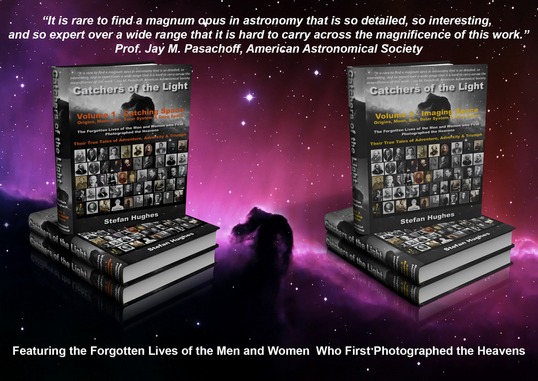‘The Devoted Couple’

William Huggins
Born: 7th February 1824, Cornhill, London, England
Died: 12th May 1910; Brixton, London, England
Lady Margaret Lindsay Murray
Born: 14th August 1848, Dublin, Ireland
Died: 24th March 1915, Chelsea, Middlesex, England
Sir William Huggins was a one of the founders of modern Astrophysics. He and his wife Margaret Lindsay Murray conducted some of the earliest research into the spectra of stars, and contributed greatly to our knowledge of the physical structure of the universe based on a common set of chemical elements.
For the very first time man began to glimpse the sheer size of what he saw when he looked up at the night sky from the Earth; a planet which he now realized was nothing more than a speck of dust in the cosmic scheme of things.
How must Friedrich Wilhelm Bessel (1784-1846) have felt in 1838 when he calculated the distance to the star 61 Cygni to be an incredible 10.4 light years away – or to put it in terrestrial distances, a staggering 98,391,159,596,914,840.32 km? , which is the equivalent of travelling 2,455,175,535,793 times round the Earth’s Equator in a plane! Such distances are in truth beyond our comprehension.
Tremendous though the achievement of Bessel was, it was only the beginning. At that time nobody had any idea of what a star really was, or what it was made up of; and they certainly knew even less about the many objects known as ‘nebulae’ which astronomers were beginning to find in ever increasing numbers as faint ‘smudges’ in the eyepieces of their telescopes.
All of this was about to change in the early 1800s with the birth of the new branch of Astronomy known as Astrophysics; which was concerned, not with position and measurement of the old days, but with the very make up and workings of the universe itself. The customers who patronized the London premises of William Thomas Huggins, silk mercer and linen draper, during the middle years of the nineteenth century, may well have been served by his young son William Huggins (1824-1910); little knowing that they had met someone who would soon begin to add pieces to a jigsaw puzzle, which when complete would explain the very nature of the universe in which they shopped.
In the years following the publication of his first scientific paper in 1856, Sir William Huggins, as he was later to become, carried out some of the very earliest investigations into Astronomical Spectroscopy in which he hoped to ‘discover whether the same chemical elements as those of our earth are present throughout the universe…’ At the time of his death in 1910 he was in a position to write that it ‘was most satisfactorily settled in the affirmative; a common chemistry, it was shown, exists throughout the universe.’
It has been said that Sir William Huggins was the ‘Father of Astronomical Spectroscopy’, but if this so then his wife Lady Margaret Lindsay Murray (1848-1915) was its mother. In the years following their marriage in 1875, she was not only his wife, but a friend, an assistant, a photographer and a co-worker. It was Margaret Lindsay Murray who introduced photography as an integral and necessary element of their 35 years of devotion to each other and to their work.
To read more on their lives and work read the eBook chapter on William Huggins & Margaret Lindsay Murray or buy the Book 'Catchers of the Light'.

Photographic Spectra of Bright Stars, Sir William Huggins & Lady Margaret Huggins

Buy the eBook or Printed Book at the 'Catchers of the Light' shop.